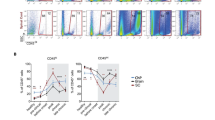Conclusions
At this stage, the only cell population that is directly implicated in the induction of fatal lymphocytic choriomeningitis is the class I MHC-restricted immune T cell. However, it is not clear that cell-mediated lysis is central to the development of neurological symptoms or that the T cells act alone to cause immunopathology.
Similar content being viewed by others
References
Allan JE, Doherty PC (1985) Immune T cells can protect or induce fatal neurological disease in murine lymphocytic choriomeningitis. Cell Immunol 90:401–407
Allan JE, Doherty PC (1985) Consequences of a single Ir-gene defect for the pathogenesis of lymphocytic choriomeningitis. Immunogenetics 21:581–590
Allan JE, Doherty PC (1985) Consequences of cyclophosphamide treatment in murine lymphocytic choriomeningitis: evidence for cytotoxic T cell replicationin vivo. Scand J Immunol 22:367–379
Austyn JM, Gordon S (1981) F4/80: a monoclonal antibody directed specifically against the mouse macrophage. Eur J Immunol 11:805–815
Bowern NA, Ramshaw IA, Clark IA, Doherty PC (1984) Inhibition of autoimmune neuropathological process by treatment with an iron chelating agent. J Exp Med 160:1532–1543
Doherty PC (1986) Virus-immune T cells and the major histocompatibility complex: evolution of some basic concepts over the past two years. Experientia (in press)
Doherty PC, Allen JE (1985) Participation of cyclophosphamide-resistant T cells in murine lymphocytic choriomeningitis. Scand J Immunol 21:127–132
Halliwell B (1982) Production of superoxide, hydrogen peroxide and hydroxyl radicals by phagocytic cells: a cause of chronic inflammatory disease? Cell Biol Int Rep 6:529–542
Pfau CJ, Saron MF, Pevear DC (1985) Lack of correlation between cytotoxic T lymphocytes and lethal murine lymphocytic choriomeningitis. J Immunol 13:597–602
Thomsen AR, Bro-JØrgensen K, Volkert M (1983) Fatal meningitis following lymphocytic choriomeningitis virus infection reflects delayed-type hypersensitivity rather than cytotoxicity. Scand J Immunol 17:139–145
Author information
Authors and Affiliations
Rights and permissions
About this article
Cite this article
Doherty, P.C., Bowern, N.A., Dixon, J.E. et al. Characteristics of the inflammatory process in murine lymphocytic choriomeningitis. Med Microbiol Immunol 175, 193–195 (1986). https://doi.org/10.1007/BF02122449
Issue Date:
DOI: https://doi.org/10.1007/BF02122449




